Unit 5 Revealing nature Understanding ideas课件(共39张PPT)-高中英语外研版(2019)选择性必修第一册(共39页PPT)
文档属性
| 名称 | Unit 5 Revealing nature Understanding ideas课件(共39张PPT)-高中英语外研版(2019)选择性必修第一册(共39页PPT) | 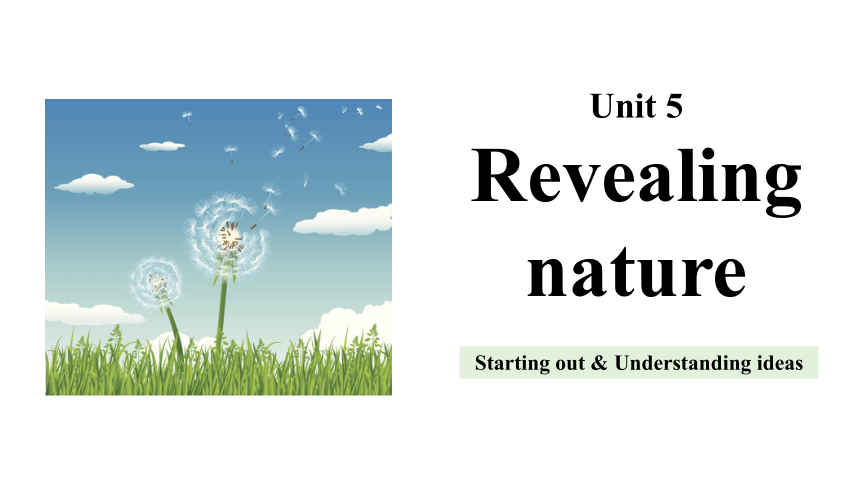 | |
| 格式 | pptx | ||
| 文件大小 | 101.9MB | ||
| 资源类型 | 教案 | ||
| 版本资源 | 外研版(2019) | ||
| 科目 | 英语 | ||
| 更新时间 | 2025-06-19 17:02:36 | ||
图片预览


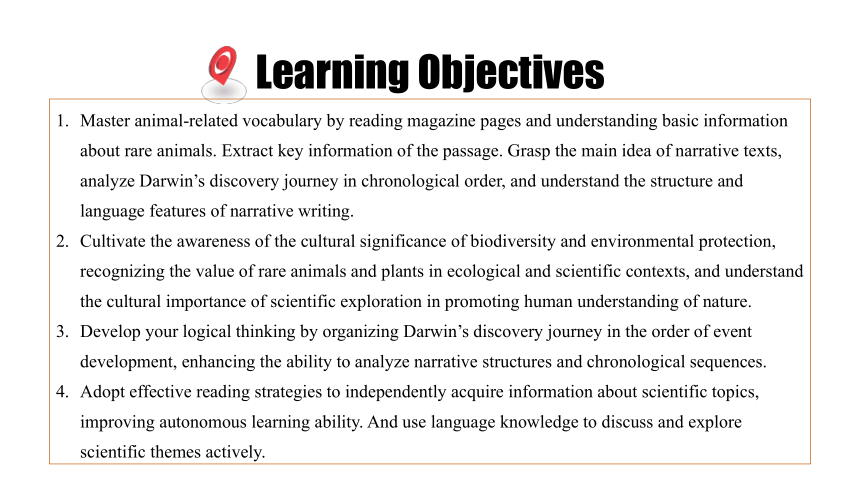
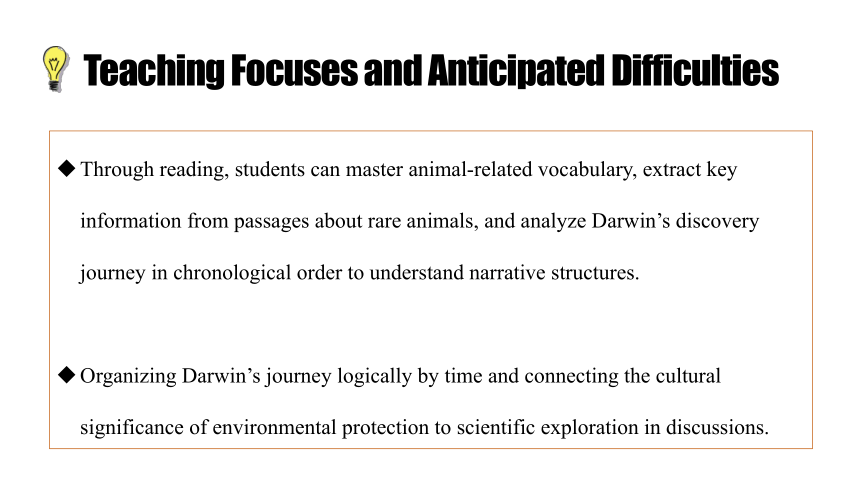



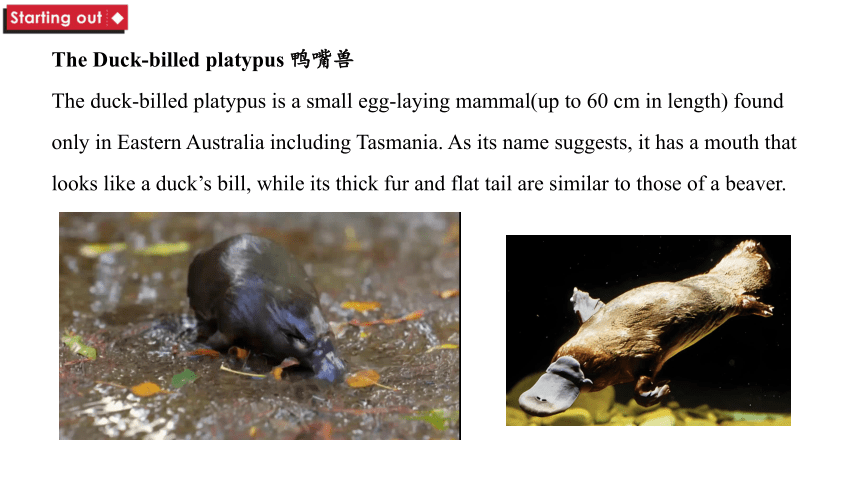
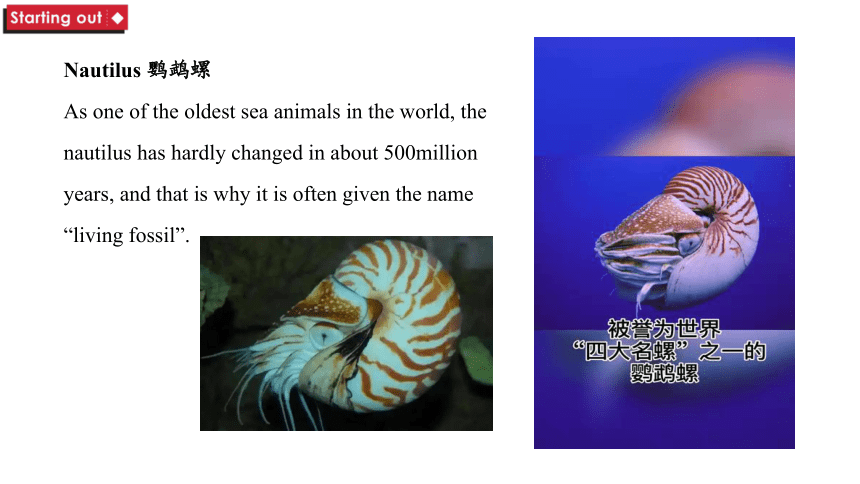


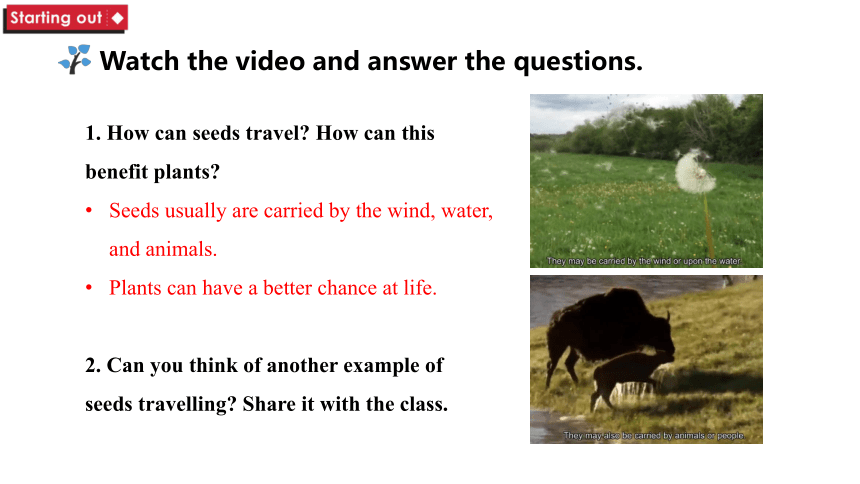
文档简介
(共38张PPT)
Unit 5
Revealing
nature
Starting out & Understanding ideas
Learning Objectives
PART. 01
Understand the daily study and life of British middle school students by watching videos. Based on your own daily study and life, compare the study and life in Chinese and British schools, and find out the similarities and differences between the two. Talk about your first impression of high school life, and have a preliminary perception of the study and life in the senior high school stage.
Learning Objectives
Master animal-related vocabulary by reading magazine pages and understanding basic information about rare animals. Extract key information of the passage. Grasp the main idea of narrative texts, analyze Darwin’s discovery journey in chronological order, and understand the structure and language features of narrative writing.
Cultivate the awareness of the cultural significance of biodiversity and environmental protection, recognizing the value of rare animals and plants in ecological and scientific contexts, and understand the cultural importance of scientific exploration in promoting human understanding of nature.
Develop your logical thinking by organizing Darwin’s discovery journey in the order of event development, enhancing the ability to analyze narrative structures and chronological sequences.
Adopt effective reading strategies to independently acquire information about scientific topics, improving autonomous learning ability. And use language knowledge to discuss and explore scientific themes actively.
Understand the daily study and life of British middle school students by watching videos. Based on your own daily study and life, compare the study and life in Chinese and British schools, and find out the similarities and differences between the two. Talk about your first impression of high school life, and have a preliminary perception of the study and life in the senior high school stage.
Teaching Focuses and Anticipated Difficulties
Through reading, students can master animal-related vocabulary, extract key information from passages about rare animals, and analyze Darwin’s discovery journey in chronological order to understand narrative structures.
Organizing Darwin’s journey logically by time and connecting the cultural significance of environmental protection to scientific exploration in discussions.
Lead-in
PART. 02
Do you like animals Do you recognize these animals
The Komodo dragon 科莫多巨蜥
The Komodo dragon is the largest lizard in the world. It can grow to three metres in length and can weigh about 135 kilograms. Despite its size and weight, it can run for short distances at up to 20 kilometres per hour.
The Duck-billed platypus 鸭嘴兽
The duck-billed platypus is a small egg-laying mammal(up to 60 cm in length) found only in Eastern Australia including Tasmania. As its name suggests, it has a mouth that looks like a duck’s bill, while its thick fur and flat tail are similar to those of a beaver.
Nautilus 鹦鹉螺
As one of the oldest sea animals in the world, the nautilus has hardly changed in about 500million years, and that is why it is often given the name “living fossil”.
Look at the page from a science magazine and answer the questions.
1. What do you know about these animals What makes them special
They are all species that exist thousands of years on earth. They are old and rare (unusual).
2. What other similar animals do you know about Share your knowledge with the class.
Watch the video and answer the questions.
1. How can seeds travel How can this benefit plants
Seeds usually are carried by the wind, water, and animals.
Plants can have a better chance at life.
2. Can you think of another example of seeds travelling Share it with the class.
Watch the video and answer the questions.
Reading
PART. 03
Look at the evolutionary tree and answer the questions.
evolutionary
tree
1. What species do you recognise in the picture
Paramecium, earthworm, snail, crab, fish, tortoise, bird, horse, human, frog, alga, moss, fern...
2. What factors can cause the process of evolution
Read the passage and talk about your understanding of the title.
A Journey of Discovery
Read the passage and talk about your understanding of the title.
A Journey of Discovery
Most commonly, people believe that a journey means a trip from one place to another, especially over a long distance and literarily a journey refers to the process by which something gradually changes and develops. The title may indicate that Darwin’s research work leading to his discovery of evolution and the origin of species took quite a long time and great efforts, determination and courage to achieve.
Charles Darwin and his Theory of Evolution
Charles Darwin (1809-1882) was an English geologist and naturalist. In his famous book On the Origin of Species, Darwin proposed the theory that organisms (individual life forms) evolve extremely slowly. He stated that the organisms that were better suited to their environments would survive and pass on their favourable characteristics to the next generation, while the less suitable organisms would gradually die out. He called this process “natural selection”.
Darwin’s Theory of Evolution is one of the basic foundations of modern science. It shows that plants and animals can change over time. The changes are usually small and difficult to detect, but they add up over many generations and can result in new species.
Choose the main idea of the passage and give your reasons.
Darwin’s interest in various living things made him a great naturalist.
Darwin’s journey on the Beagle inspired his Theory of Evolution.
Darwin went on a journey to confirm his theory that humans had evolved over time.
Read the passage and match each paragraph with its main idea.
Para. 1
Para. 3
Para. 4
Para. 2
e. Darwin was not the captain’s first choice but his adventures on the Beagle led to one of the most important scientific discoveries of all time.
a. Darwin began his journey.
f. Darwin began to think differently.
c. Some bird on the Galápagos Islands interested Darwin.
g. Darwin suspected that the birds evloved from earlier ancestors.
Para. 5
b. More and more people started to believe Darwin’s theory of evolution.
d. On the Origin of Species is regarded as one of the most important works ever written.
Para. 6
Para. 7
Organise information from the passage and complete the diagram.
1. On his journey
Darwin studied various living things in their natural environments and samples of the plants and animals he had collected.
He noticed that some species of animals were very similar to each other.
2. Generate ideas
Darwin asked the questions:
How did different species come to exist
Maybe animals evolved as they adapted to their changing environments
Organise information from the passage and complete the diagram.
3. Look for more evidence
On the Galápagos Islands:
He noticed that there was a difference between the finches on each of the islands.
It seemed the beaks had evolved according to what food was available on that particular island.
4. Develop ideas
Darwin suspected that the finches had evolved from a common ancestor, which had arrived on the islands a long time before and it had slowly evolved into many new species.
Organise information from the passage and complete the diagram.
5. Propose a theory
The Theory of Evolution: living things, including humans, had evolved from lower forms of life.
Now discuss why Darwin did not publish his Theory of Evolution until 1859, about twenty years after his discovery. Do further research if necessary.
Choose the best answer for the following questions according to the passage.
1. Why didn’t the captain of the Beagle think Darwin was the best choice
A. Because Darwin wasn’t admitted to a university.
B. Because Darwin was dismissed from medical school.
C. Because Darwin brought shame to himself and his family.
D. Because Darwin had not enough interest in visiting distant countries.
2. What did people think about the species at that time
A. All species evolved from the same species.
B. All species came into being in the meantime.
C. Some species appeared earlier than the others
D. Some species improved a lot since its appearance.
Choose the best answer for the following questions according to the passage.
3. What was Darwin’s new theory then
A. Environment played an important role.
B. Species evolved with the changing environment.
C. Different species lived in different environment.
D. The more complicated the species were, the more time it took.
4. How did people feel Darwin’s theory
A. Astonished. B. Excited.
C. Satisfied. D. Interested.
Think & share
1. Why were many people “shocked” by Darwin’s theory
At that time, people believed that all species had appeared on Earth at the same time and had not changed since, but Darwin’s theory proposed that living things, including humans, had evolved from lower forms of life, which, as a result, shocked many people.
What kind of person was Darwin according to the passage
Think & share
2. What kind of person was Darwin according to the passage
Darwin was a determined man. He had strong curiosity and interest in science and was good at thinking and making discoveries.
3. How do you think the human species will evolve in the future
4. What have you learnt about the spirit of scientific exploration How can this spirit help you in your life and studies
Vocabulary
1. distant
be distant from 离……很远;与……不同,与……关系不密切
in the distance 在远处(距离很远)
at/from a distance 从远处,离一段距离(不是很远)
keep one’s distance 保持距离
at a distance of 隔……远的距离
keep sb. at a distance 与某人保持距离
例题:
The remote village is distant _____ major cities, relying on weekly supplies delivered by truck.
from
Vocabulary
2. disgrace
disgraceful adj. 不光彩的;可耻的;丢脸的
disgracefully adv. 可耻地
be a disgrace 是耻辱,是丢脸的事
disgrace oneself 丢脸
It’s disgraceful that... ……太不像话了
There is no disgrace in doing sth. 做某事不丢脸
例题:
It’s ___________(disgrace) that some people litter in public places despite clear signs.
disgraceful
Vocabulary
3. suspect
suspicion n. 怀疑;嫌疑
suspicious adj. 怀疑的;可疑的;不信任的
suspect that... 怀疑……
suspect sb. to be... 怀疑某人是……
suspect sb. of (doing) sth. 怀疑某人(做)某事
be under suspicion 受到怀疑
on suspicion of 因涉嫌……
be/become suspicious about/of sb./sth 怀疑某人/某事
be suspicious of sb./sth. 不信任某人/某事
例题:
She viewed his sudden kindness with __________(suspect), wondering what he wanted.
suspicion
Exercise
PART. 04
1. The new shopping mall is expected to g_________(创造) thousands of jobs for the local community.
2. Researchers collected water s_______(样本) from the river to analyze pollutant levels.
3. Childhood experiences can plant the s_______(种子) of future career choices in many people.
4. Her a________(祖先) migrated from Europe to America in the 19th century in search of better opportunities.
enerate
Exercise: 单词拼写
amples
eeds
ncestor
1. The excessive pollution caused by the factory _____________ to the company’s claim of environmental responsibility.
2. The custom of eating zongzi during the Dragon Boat Festival _____________ over 2,000 years ago.
3. Many graduates _______________ to teach in rural areas, bridging the education gap in underserved communities.
4. The team tested the material _____________ thoroughly.
is a disgrace
Exercise: 用所给短语的适当形式填空
dates back to
answer the call
in question
answer the call be a disgrace in question date back to
Summary
PART. 05
添加标题
ADD THE TITLE HERE
添加标题
ADD THE TITLE HERE
添加标题
ADD THE TITLE HERE
添加标题
ADD THE TITLE HERE
Starting out & Understanding ideas
Learning about basic information about rare animals
Reading
Vocabulary
the main idea and the structure of the passage
analyze Darwin’s discovery journey in chronological order
Homework
PART. 06
Find more information about Darwin.
Considering whether humans will still evolve in the future.
Homework
See you next class!
Unit 5
Revealing
nature
Starting out & Understanding ideas
Learning Objectives
PART. 01
Understand the daily study and life of British middle school students by watching videos. Based on your own daily study and life, compare the study and life in Chinese and British schools, and find out the similarities and differences between the two. Talk about your first impression of high school life, and have a preliminary perception of the study and life in the senior high school stage.
Learning Objectives
Master animal-related vocabulary by reading magazine pages and understanding basic information about rare animals. Extract key information of the passage. Grasp the main idea of narrative texts, analyze Darwin’s discovery journey in chronological order, and understand the structure and language features of narrative writing.
Cultivate the awareness of the cultural significance of biodiversity and environmental protection, recognizing the value of rare animals and plants in ecological and scientific contexts, and understand the cultural importance of scientific exploration in promoting human understanding of nature.
Develop your logical thinking by organizing Darwin’s discovery journey in the order of event development, enhancing the ability to analyze narrative structures and chronological sequences.
Adopt effective reading strategies to independently acquire information about scientific topics, improving autonomous learning ability. And use language knowledge to discuss and explore scientific themes actively.
Understand the daily study and life of British middle school students by watching videos. Based on your own daily study and life, compare the study and life in Chinese and British schools, and find out the similarities and differences between the two. Talk about your first impression of high school life, and have a preliminary perception of the study and life in the senior high school stage.
Teaching Focuses and Anticipated Difficulties
Through reading, students can master animal-related vocabulary, extract key information from passages about rare animals, and analyze Darwin’s discovery journey in chronological order to understand narrative structures.
Organizing Darwin’s journey logically by time and connecting the cultural significance of environmental protection to scientific exploration in discussions.
Lead-in
PART. 02
Do you like animals Do you recognize these animals
The Komodo dragon 科莫多巨蜥
The Komodo dragon is the largest lizard in the world. It can grow to three metres in length and can weigh about 135 kilograms. Despite its size and weight, it can run for short distances at up to 20 kilometres per hour.
The Duck-billed platypus 鸭嘴兽
The duck-billed platypus is a small egg-laying mammal(up to 60 cm in length) found only in Eastern Australia including Tasmania. As its name suggests, it has a mouth that looks like a duck’s bill, while its thick fur and flat tail are similar to those of a beaver.
Nautilus 鹦鹉螺
As one of the oldest sea animals in the world, the nautilus has hardly changed in about 500million years, and that is why it is often given the name “living fossil”.
Look at the page from a science magazine and answer the questions.
1. What do you know about these animals What makes them special
They are all species that exist thousands of years on earth. They are old and rare (unusual).
2. What other similar animals do you know about Share your knowledge with the class.
Watch the video and answer the questions.
1. How can seeds travel How can this benefit plants
Seeds usually are carried by the wind, water, and animals.
Plants can have a better chance at life.
2. Can you think of another example of seeds travelling Share it with the class.
Watch the video and answer the questions.
Reading
PART. 03
Look at the evolutionary tree and answer the questions.
evolutionary
tree
1. What species do you recognise in the picture
Paramecium, earthworm, snail, crab, fish, tortoise, bird, horse, human, frog, alga, moss, fern...
2. What factors can cause the process of evolution
Read the passage and talk about your understanding of the title.
A Journey of Discovery
Read the passage and talk about your understanding of the title.
A Journey of Discovery
Most commonly, people believe that a journey means a trip from one place to another, especially over a long distance and literarily a journey refers to the process by which something gradually changes and develops. The title may indicate that Darwin’s research work leading to his discovery of evolution and the origin of species took quite a long time and great efforts, determination and courage to achieve.
Charles Darwin and his Theory of Evolution
Charles Darwin (1809-1882) was an English geologist and naturalist. In his famous book On the Origin of Species, Darwin proposed the theory that organisms (individual life forms) evolve extremely slowly. He stated that the organisms that were better suited to their environments would survive and pass on their favourable characteristics to the next generation, while the less suitable organisms would gradually die out. He called this process “natural selection”.
Darwin’s Theory of Evolution is one of the basic foundations of modern science. It shows that plants and animals can change over time. The changes are usually small and difficult to detect, but they add up over many generations and can result in new species.
Choose the main idea of the passage and give your reasons.
Darwin’s interest in various living things made him a great naturalist.
Darwin’s journey on the Beagle inspired his Theory of Evolution.
Darwin went on a journey to confirm his theory that humans had evolved over time.
Read the passage and match each paragraph with its main idea.
Para. 1
Para. 3
Para. 4
Para. 2
e. Darwin was not the captain’s first choice but his adventures on the Beagle led to one of the most important scientific discoveries of all time.
a. Darwin began his journey.
f. Darwin began to think differently.
c. Some bird on the Galápagos Islands interested Darwin.
g. Darwin suspected that the birds evloved from earlier ancestors.
Para. 5
b. More and more people started to believe Darwin’s theory of evolution.
d. On the Origin of Species is regarded as one of the most important works ever written.
Para. 6
Para. 7
Organise information from the passage and complete the diagram.
1. On his journey
Darwin studied various living things in their natural environments and samples of the plants and animals he had collected.
He noticed that some species of animals were very similar to each other.
2. Generate ideas
Darwin asked the questions:
How did different species come to exist
Maybe animals evolved as they adapted to their changing environments
Organise information from the passage and complete the diagram.
3. Look for more evidence
On the Galápagos Islands:
He noticed that there was a difference between the finches on each of the islands.
It seemed the beaks had evolved according to what food was available on that particular island.
4. Develop ideas
Darwin suspected that the finches had evolved from a common ancestor, which had arrived on the islands a long time before and it had slowly evolved into many new species.
Organise information from the passage and complete the diagram.
5. Propose a theory
The Theory of Evolution: living things, including humans, had evolved from lower forms of life.
Now discuss why Darwin did not publish his Theory of Evolution until 1859, about twenty years after his discovery. Do further research if necessary.
Choose the best answer for the following questions according to the passage.
1. Why didn’t the captain of the Beagle think Darwin was the best choice
A. Because Darwin wasn’t admitted to a university.
B. Because Darwin was dismissed from medical school.
C. Because Darwin brought shame to himself and his family.
D. Because Darwin had not enough interest in visiting distant countries.
2. What did people think about the species at that time
A. All species evolved from the same species.
B. All species came into being in the meantime.
C. Some species appeared earlier than the others
D. Some species improved a lot since its appearance.
Choose the best answer for the following questions according to the passage.
3. What was Darwin’s new theory then
A. Environment played an important role.
B. Species evolved with the changing environment.
C. Different species lived in different environment.
D. The more complicated the species were, the more time it took.
4. How did people feel Darwin’s theory
A. Astonished. B. Excited.
C. Satisfied. D. Interested.
Think & share
1. Why were many people “shocked” by Darwin’s theory
At that time, people believed that all species had appeared on Earth at the same time and had not changed since, but Darwin’s theory proposed that living things, including humans, had evolved from lower forms of life, which, as a result, shocked many people.
What kind of person was Darwin according to the passage
Think & share
2. What kind of person was Darwin according to the passage
Darwin was a determined man. He had strong curiosity and interest in science and was good at thinking and making discoveries.
3. How do you think the human species will evolve in the future
4. What have you learnt about the spirit of scientific exploration How can this spirit help you in your life and studies
Vocabulary
1. distant
be distant from 离……很远;与……不同,与……关系不密切
in the distance 在远处(距离很远)
at/from a distance 从远处,离一段距离(不是很远)
keep one’s distance 保持距离
at a distance of 隔……远的距离
keep sb. at a distance 与某人保持距离
例题:
The remote village is distant _____ major cities, relying on weekly supplies delivered by truck.
from
Vocabulary
2. disgrace
disgraceful adj. 不光彩的;可耻的;丢脸的
disgracefully adv. 可耻地
be a disgrace 是耻辱,是丢脸的事
disgrace oneself 丢脸
It’s disgraceful that... ……太不像话了
There is no disgrace in doing sth. 做某事不丢脸
例题:
It’s ___________(disgrace) that some people litter in public places despite clear signs.
disgraceful
Vocabulary
3. suspect
suspicion n. 怀疑;嫌疑
suspicious adj. 怀疑的;可疑的;不信任的
suspect that... 怀疑……
suspect sb. to be... 怀疑某人是……
suspect sb. of (doing) sth. 怀疑某人(做)某事
be under suspicion 受到怀疑
on suspicion of 因涉嫌……
be/become suspicious about/of sb./sth 怀疑某人/某事
be suspicious of sb./sth. 不信任某人/某事
例题:
She viewed his sudden kindness with __________(suspect), wondering what he wanted.
suspicion
Exercise
PART. 04
1. The new shopping mall is expected to g_________(创造) thousands of jobs for the local community.
2. Researchers collected water s_______(样本) from the river to analyze pollutant levels.
3. Childhood experiences can plant the s_______(种子) of future career choices in many people.
4. Her a________(祖先) migrated from Europe to America in the 19th century in search of better opportunities.
enerate
Exercise: 单词拼写
amples
eeds
ncestor
1. The excessive pollution caused by the factory _____________ to the company’s claim of environmental responsibility.
2. The custom of eating zongzi during the Dragon Boat Festival _____________ over 2,000 years ago.
3. Many graduates _______________ to teach in rural areas, bridging the education gap in underserved communities.
4. The team tested the material _____________ thoroughly.
is a disgrace
Exercise: 用所给短语的适当形式填空
dates back to
answer the call
in question
answer the call be a disgrace in question date back to
Summary
PART. 05
添加标题
ADD THE TITLE HERE
添加标题
ADD THE TITLE HERE
添加标题
ADD THE TITLE HERE
添加标题
ADD THE TITLE HERE
Starting out & Understanding ideas
Learning about basic information about rare animals
Reading
Vocabulary
the main idea and the structure of the passage
analyze Darwin’s discovery journey in chronological order
Homework
PART. 06
Find more information about Darwin.
Considering whether humans will still evolve in the future.
Homework
See you next class!
